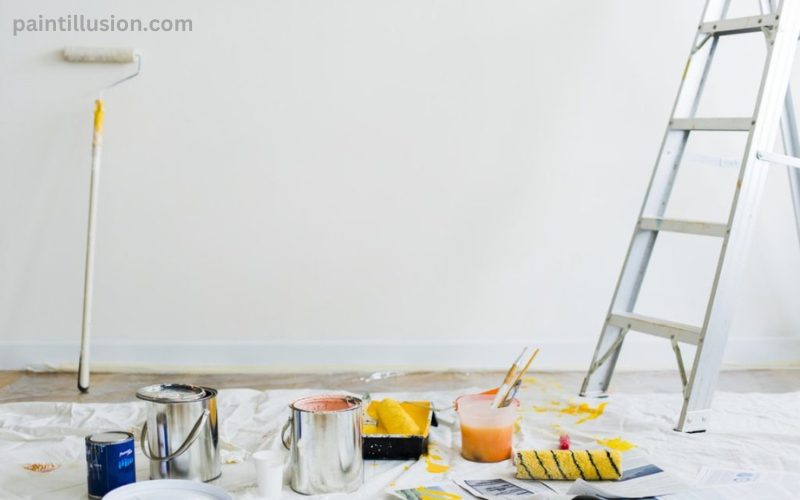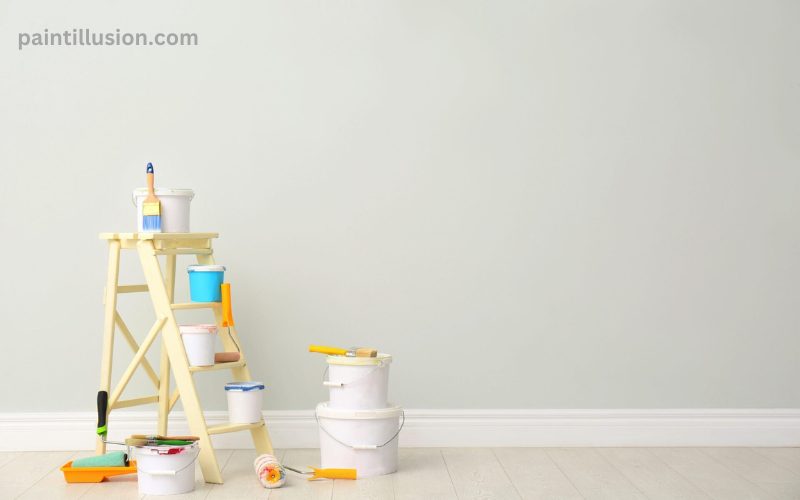When it comes to painting the exterior of your home or any outdoor surface, it’s important to choose the right type of paint. Many people wonder if they can use interior paint outside, but this decision should not be taken lightly. In this article, we will explore the differences between interior and exterior paint, the risks and potential issues of using interior paint outside, factors to consider before making this decision, alternatives to using interior paint for exterior surfaces, steps to properly prepare exterior surfaces for paint, choosing the right paint for exterior surfaces, tips for a successful exterior painting project, common mistakes to avoid when using interior paint outside, and finally, a conclusion to summarize everything we have discussed.
Understanding the Differences Between Interior and Exterior Paint
Interior and exterior paint are specifically formulated for different purposes and environments. Interior paint is designed for use inside the house where there is less exposure to sunlight, moisture, and extreme temperatures. It is formulated to be more resistant to stains, easy to clean, and provide a smooth finish. On the other hand, exterior paint is specifically engineered to withstand harsh weather conditions, including UV rays from the sun, rain, snow, and fluctuating temperatures. It is designed to be more durable, fade-resistant, and provide better protection against moisture and mold.
Using interior paint outside can lead to several problems. First, interior paint lacks the necessary UV protection to withstand sun exposure, causing it to fade quickly. Additionally, it is not as resistant to moisture, which can lead to peeling, cracking, and mold growth. Moreover, interior paint may not adhere well to exterior surfaces, resulting in a shorter lifespan and the need for frequent repainting. It is essential to understand these differences before considering the use of interior paint outside.

Risks and Potential Issues of Using Interior Paint Outside
Using interior paint outside can lead to various risks and potential issues. As mentioned earlier, interior paint is not designed to withstand the harsh elements that exterior surfaces are exposed to. One significant risk is the premature deterioration of the paint, resulting in a less appealing appearance and the need for frequent maintenance. The lack of proper UV protection can cause the color to fade quickly, making your paint job look worn out and dull.
Another potential issue is the lack of moisture resistance. Exterior surfaces are constantly exposed to rain, snow, and humidity, making them prone to moisture-related problems. Interior paint may not have the necessary water-resistant properties, leading to peeling, cracking, and mold growth over time. Moreover, using interior paint outside can void any warranties or guarantees provided by the paint manufacturer, leaving you responsible for any repairs or repainting that may be needed.
Factors to Consider Before Using Interior Paint Outside
Before using interior paint outside, there are several important factors to consider. First, evaluate the climate in your area. If you live in an area with extreme temperature fluctuations, high humidity, or heavy rainfall, using interior paint outside is not recommended. These conditions can cause the paint to deteriorate quickly and lead to costly repairs. Additionally, consider the level of exposure to sunlight. If the surface you plan to paint is in direct sunlight for long periods, interior paint will fade faster and require more frequent repainting.
Another factor to consider is the type of surface you intend to paint. Exterior surfaces are often more porous and require a paint that can adhere properly and provide adequate protection. Interior paint may not bond well to these surfaces, resulting in a shorter lifespan and a compromised finish. Additionally, think about the purpose of the surface. If it is a high-traffic area or prone to moisture, using interior paint outside is not recommended due to its lack of durability and water resistance.
Alternatives to Using Interior Paint for Exterior Surfaces
If you have decided that using interior paint outside is not suitable for your project, there are several alternatives to consider. One option is to use exterior paint specifically formulated for the type of surface you plan to paint. Exterior paint is designed to withstand the elements and provide long-lasting protection. It has UV-resistant properties, excellent adhesion to exterior surfaces, and better resistance to moisture, mold, and fading. Investing in the right paint can save you time and money in the long run.
Another alternative is to consider specialized coatings such as masonry paint or elastomeric paint for specific surfaces like concrete or stucco. These coatings are specifically formulated to provide enhanced protection and durability for these types of surfaces. They offer superior adhesion, flexibility to withstand expansion and contraction, and resistance to cracking and water penetration. Using the appropriate coating for the surface you are painting will ensure better results and longevity.
Steps to Properly Preparing Exterior Surfaces for Paint
Before painting any exterior surface, proper preparation is crucial for a successful and long-lasting paint job. Here are the steps you should follow to ensure the surface is ready for paint:
- Clean the surface thoroughly: Remove any dirt, dust, mold, or mildew using a pressure washer or a scrub brush and detergent. Make sure the surface is completely dry before proceeding.
- Repair any damage: Inspect the surface for any cracks, holes, or damaged areas. Fill them with an appropriate filler or patching compound, and sand smooth once dry.
- Remove loose paint: Scrape off any loose or peeling paint using a putty knife or scraper. Sand the edges of the remaining paint to create a smooth transition between old and new paint.
- Prime the surface: Apply a coat of primer to ensure proper adhesion and create a uniform surface for the paint. Choose a primer suitable for the type of surface you are painting.
- Caulk and seal gaps: Use a high-quality caulk to seal any gaps, cracks, or joints to prevent water infiltration and improve the overall appearance of the paint job.
Choosing the Right Paint for Exterior Surfaces
Choosing the right paint for exterior surfaces is crucial to ensure a long-lasting and visually appealing finish. Here are some factors to consider when selecting paint:
- Paint type: Opt for exterior paint specifically formulated for the surface you are painting, such as wood, metal, or masonry. These paints have the necessary properties to withstand the elements and provide superior protection.
- Durability: Look for a paint that offers excellent durability and resistance to peeling, cracking, and fading. It should be able to withstand UV rays, moisture, and temperature fluctuations without compromising its appearance.
- Color selection: Consider the color you want to use and its suitability for the exterior environment. Dark colors tend to absorb more heat and fade faster, while lighter colors are more reflective and may require less maintenance.
- Finish: Choose the appropriate finish for the surface you are painting. Flat finishes hide imperfections but are less resistant to stains and difficult to clean. Satin or semi-gloss finishes are more durable and easier to clean, making them suitable for high-traffic areas.
Tips for a Successful Exterior Painting Project
To ensure a successful exterior painting project, here are some additional tips to keep in mind:
- Plan ahead: Proper planning is essential for a smooth painting process. Consider the weather conditions, time required for preparation, and the number of coats needed.
- Prepare the surface properly: As discussed earlier, thorough surface preparation is crucial for a long-lasting paint job. Take the time to clean, repair, and prime the surface before applying paint.
- Use the right tools: Invest in high-quality brushes, rollers, and other painting tools. Using the correct tools will result in a more professional-looking finish and make the job easier and more efficient.
- Follow the manufacturer’s instructions: Read and follow the instructions provided by the paint manufacturer. This includes proper application techniques, drying times, and any specific recommendations for the type of paint you are using.
- Apply multiple thin coats: Instead of applying one thick coat, it is better to apply multiple thin coats. This ensures better adhesion, durability, and a smoother finish.
- Allow sufficient drying time: Be patient and allow each coat of paint to dry completely before applying the next one. Rushing the process can lead to poor adhesion, streaks, and other imperfections.
Common Mistakes to Avoid When Using Interior Paint Outside
Using interior paint outside can lead to several common mistakes that should be avoided. Here are some of them:
- Neglecting surface preparation: Properly preparing the surface is crucial for a successful paint job. Skipping this step can result in poor adhesion, peeling, and other issues.
- Not using exterior-grade paint: Interior paint lacks the necessary properties to withstand the elements. Using it outside can lead to premature fading, peeling, and mold growth.
- Choosing the wrong color: Dark colors may absorb more heat and fade faster when exposed to sunlight. Consider the climate in your area and choose a color that is suitable for the exterior environment.
- Applying paint in unsuitable weather conditions: Avoid painting in extreme temperatures, high humidity, or when rain is expected. These conditions can affect the drying time and adhesion of the paint.
- Applying too thick of a coat: Applying a thick coat of paint may seem like a time-saving technique, but it can result in poor adhesion, drips, and an uneven finish. Multiple thin coats are always better.
- Overlooking proper ventilation: Ensure proper ventilation when painting to allow the paint fumes to dissipate. This will create a healthier environment for both you and the drying paint.
Conclusion
In conclusion, using interior paint outside is not recommended due to the significant differences between interior and exterior paint formulations. Interior paint lacks the necessary UV protection, moisture resistance, and durability required for exterior surfaces. It can lead to fading, peeling, cracking, and mold growth, resulting in frequent maintenance and costly repairs. Before deciding to use interior paint outside, consider the climate, level of sun exposure, type of surface, and purpose of the area you plan to paint. It is advisable to choose exterior paint specifically formulated for the type of surface you are painting or consider specialized coatings for specific surfaces. Proper surface preparation, choosing the right paint, and following the correct application techniques are crucial for a successful exterior painting project. By avoiding common mistakes and investing time and effort into your paint job, you can achieve a long-lasting and visually appealing finish that will enhance the exterior of your home or any outdoor surface.


porno teens double
porno xxx hot
black wife porno
rape girl porno
porno teens group